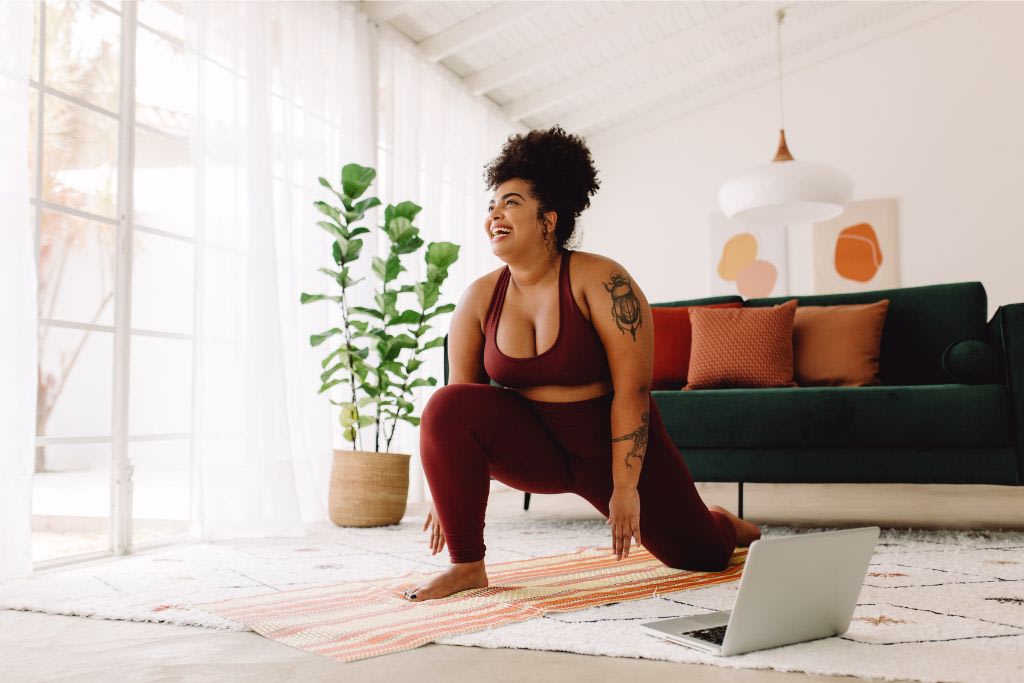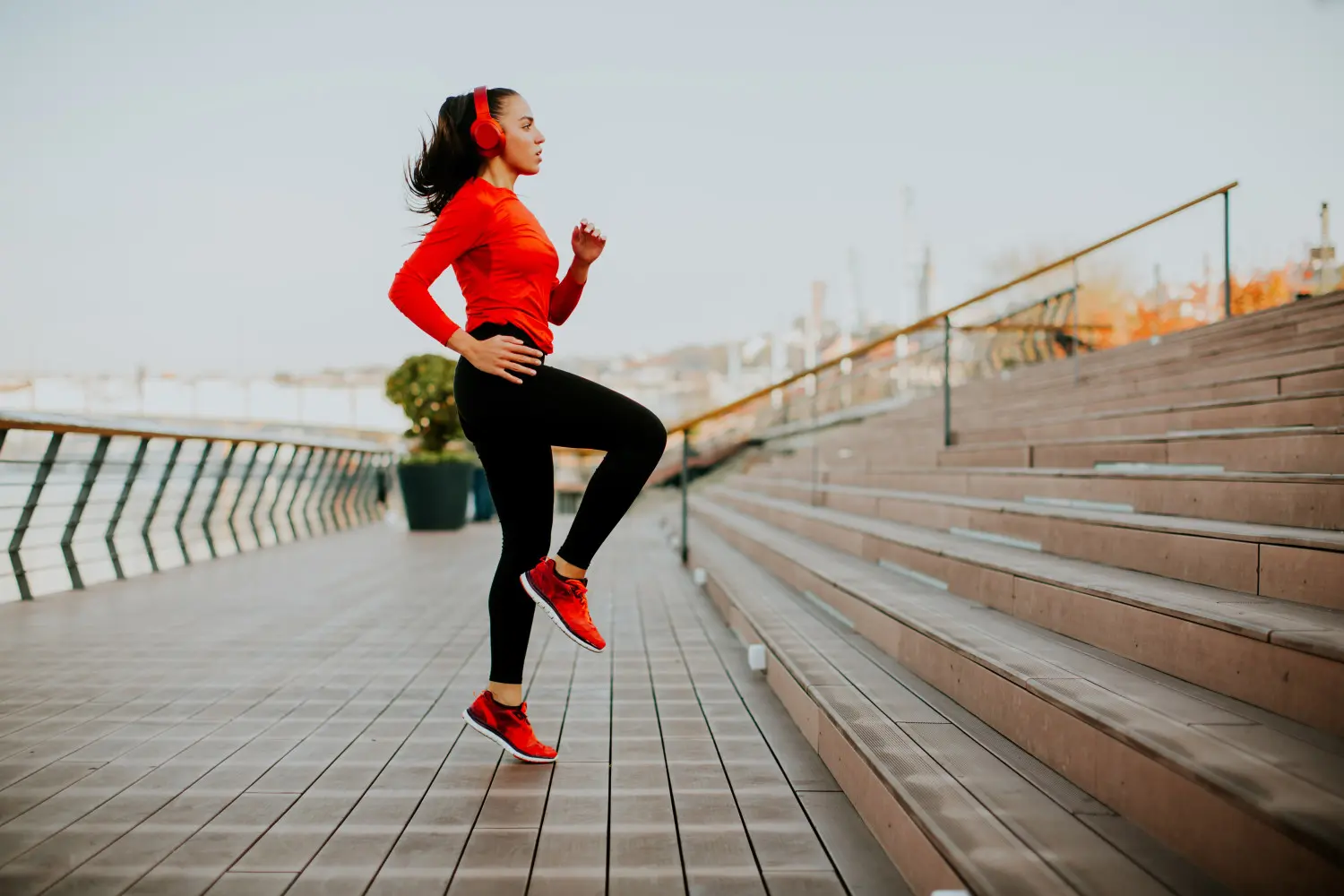How Long Does It Take To See Workout Results?
If you’ve recently started working out (or started a while ago) it’s natural to wonder when you’ll see changes. Here’s what you can expect.

September 2, 2022 - Updated January 23, 2025

When embarking on a fitness journey or starting a new Sweat program, one of the most common things we get asked is how long it takes to see results from working out. While the endorphin rush and mood boost are huge almost-instant benefits, we get it - a big source of motivation might be seeing your fitness, strength, mobility or body composition improve.
Having a rough timeline for goals like this can help you stay the course and avoid feeling discouraged or disappointed. And while you might notice some positive changes after your very first workout, some might take a few weeks, and others might take months. Good things take time, so remind yourself why this is important to you and remember this is a lifestyle, not a quick fix. We’re in this for the long game!
It’s also important to know that fitness progress looks and feels different for everyone, with ability, goals and motivation differing from person to person.
The time it takes to achieve your goals and see the results you want may vary depending on factors like your base fitness level, age, any health issues or previous injuries, how you nourish your body when you’re not training, how frequently you work out, what training style you follow, how much you challenge yourself and what resources you have available (such as time and equipment). Every body and every journey is so unique!
Because of these variables, this timeline is a general guide, rather than a one-size-fits-all approach to tracking your progress. Stay committed and consistent and try to find joy in how you choose to move - that’s where the magic happens.

1-4 weeks
One of the best things about moving your body is you don’t have to wait long to feel the benefits, and the first changes you’re likely to notice are often related to your mood, energy, sleep and confidence.
It’s common to feel an uplift in your mood from the rush of endorphins and feel-good chemicals during a workout or just after, and this energy can have a positive impact on how you feel for the rest of the day. Challenging your body and mind during your Sweat session can also leave you feeling more empowered, confident, accomplished and less stressed - one of Sweat trainer Ruba Ali’s favourite reasons to move.
One 2017 review on the effects of a single exercise session on mood, cognition and neurochemical pathways showed that the three most consistent effects on cognition or behaviour are enhanced mood, decreased stress and improved cognitive function. The American Psychological Association has also highlighted the ways exercise can improve brain function, mental health, stress and memory.
It’s not just structured workouts or a Sweat program that will have you quickly reaping the rewards of physical activity. Just 30 minutes of walking each day can do wonders for your fitness, strength and energy levels according to Australia’s Heart Foundation, with one study finding walking has a positive impact on your mood after just 10 minutes.
And if it’s a better night’s sleep you’re after? Experts at Johns Hopkins Medicine say that 30 minutes of exercise each day can help you fall asleep more quickly and improve your sleep quality. Just be mindful of when you schedule your workouts and pay attention to how your body responds, as exercising at night can keep some people awake!
If one of your goals is to see changes in your body composition such as muscle growth or fat loss (and these changes definitely aren’t a focus for everyone), don’t expect to see anything in the first few weeks, but do consider how you plan on measuring that change. This could be the time that you take photos or measurements - the scales can be deceptive!

5-12 weeks
Once you’ve been exercising consistently for a couple of months, this is where you’re likely to see three things improving: your cardio fitness, confidence and competence.
Cardio fitness
This is the sweet spot when you’ll start noticing cardiovascular fitness and VO2 max has improved, meaning you feel less out of breath and can push yourself harder than when you started. That Sweat session that may have felt tough in week one now feels much easier!
If you want to see faster improvements in your cardio fitness, exercising regularly and increasing the intensity is key. A 2007 study on the effects of different doses of physical activity on the cardio fitness of sedentary or overweight women found a strong relationship between the amount of exercise and changes in fitness, meaning the more you move, the better!
Challenging yourself with training styles such as HIIT can also have a positive effect. A 2020 study on the effects of high vs moderate-intensity interval training on resting heart rate, blood pressure and performance in older women found that HIIT promoted greater benefits for performance, function and body composition than moderate-intensity workouts.
Endurance, strength and competence
Around this time in your fitness journey, you may also start to notice improvements in your physical abilities. This could be improvements in your muscular endurance, meaning it takes a longer period of time before your muscles feel tired, or increased muscular strength, meaning you can lift heavier weights.
After weeks of practice, you might begin to see improvements in your mobility, coordination and ability to perform exercises with good form, or that your recovery time and muscle soreness (DOMS) between workouts has reduced.
Mind-body connection
Although it might not be a sign of progress visible to the naked eye, you might also discover around this time that you have a more intimate understanding of your own body. This could be in terms of signals you need rest, how you feel at different stages of your menstrual cycle, or signs your body is ready for heavier weights or a more challenging program.
For some people, this period can be the toughest as the excitement of starting a new routine has worn off, but you don’t know if you’re making progress yet. Trust the process - you are! If your motivation is hitting a wall, try taking notes after each session or week of any wins (big or small!) worth celebrating.

3 months +
At this point, you’re hopefully in a good routine and exercise has become (or is starting to become) a healthy habit and a feel-good part of your lifestyle. Even the Sweat trainers have their off days and weeks, so don’t feel disheartened if showing up for your workouts still requires a lot of discipline. Maintaining motivation is a skill in itself and a win worth celebrating, too!
Strength gains & body composition improvements
Beyond the three-month mark, you’re likely to feel much more confident with your workouts (and more confident in the gym if that’s where you train), and your muscle and strength gains will continue to improve from here on out!
This is generally when you’ll start to notice any changes in your body composition if you’ve been doing regular cardio and strength training, along with adopting healthy eating habits. You might reflect on your earlier photos or measurements and now see a shift! If building muscle or losing fat is a goal for you, remember that it’s going to take time to see changes if you are approaching it in a healthy, sustainable way.
If you’re not seeing as much progress with your strength gains, make sure you’re completing regular resistance training, challenging yourself enough, eating enough protein and getting lots of rest - the essentials for muscle growth. Progressive overload is a great way to do this, a training principle baked into many of the Sweat programs where you gradually dial up the volume, intensity, density and frequency of your workouts.
Hypertrophy workouts, like those in Kelsey Wells’ PWR Strength program and Strength & Sculpt with Katie Martin, are also designed to increase the size and strength of your muscles by focusing on time under tension.
We all want to feel like we’re making progress and moving in the right direction, but it’s important to remember some results take longer than others.
Here at Sweat we always recommend finding a style of exercise you enjoy because of how it makes you feel, and let the results be an added bonus rather than the only thing you’re chasing.

Erin is a writer and editor at Sweat with years of experience in women's publishing, the fitness industry, media and tech. She's passionate about the power of movement, and you can often find her on a yoga mat, a hike, a dance floor, in the ocean or the gym.
* Disclaimer: This blog post is not intended to replace the advice of a medical professional. The above information should not be used to diagnose, treat, or prevent any disease or medical condition. Please consult your doctor before making any changes to your diet, sleep methods, daily activity, or fitness routine. Sweat assumes no responsibility for any personal injury or damage sustained by any recommendations, opinions, or advice given in this article.
Fitness